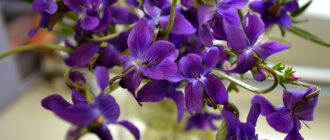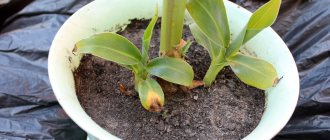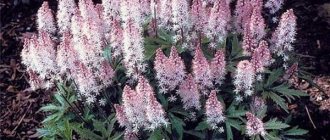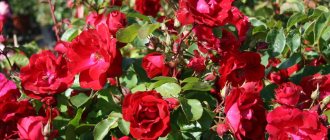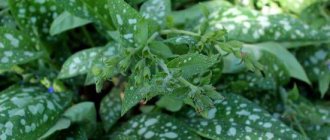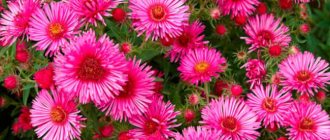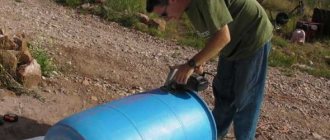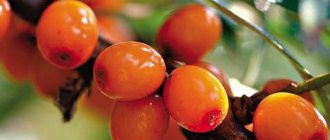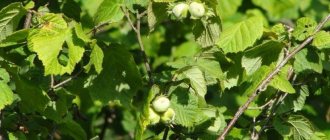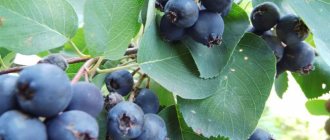Planting and caring for nectarines
- Planting: in warm areas - in autumn, in areas with cool climates - in spring, before sap flow begins.
- Flowering: from early or mid-May, until leaves appear.
- Lighting: bright sunlight: the plant should not be in the shade for more than one and a half to two hours a day.
- Soil: loamy or sandy loam soils. Clay soil and areas with high groundwater levels are not suitable.
- Watering: early varieties are watered 2-3 times during the season, mid-season and late varieties - 4-6 times. The first time nectarines are watered is when the fruit’s pit has hardened, otherwise they will crack. A month before harvesting, abundant watering is carried out, spending on each fruit-bearing tree, depending on its age, from 30 to 60 liters of water per m² of trunk circle. After harvesting the fruits, during the formation of flower buds, the flow rate is increased to 40-70 liters. In October, moisture-recharging irrigation is carried out, as a result of which the soil should get wet to a depth of 60-80 cm.
- Top dressing: the fertilizers added when planting in the pit are sufficient for 5-6 years, provided that the root area is mulched annually with humus or compost. In the future, organic matter is applied once every 3-4 years, mineral fertilizers - once every two years. In spring, nectarine needs nitrogen, and in summer and autumn - phosphorus and potassium. In spring and autumn, it is better to apply fertilizers to the tree trunk; in summer, nectarines are fertilized 2-3 times on the leaves, including with solutions of microelements the tree lacks.
- Pruning: in the spring (before the start of sap flow), sanitary and formative pruning is carried out. In the fall, if necessary, sanitary.
- Reproduction: seed and vegetative – by grafting.
- Pests: oriental and plum moths, aphids, scale insects, striped, leafminer and fruit moths, flower beetles and spider mites.
- Diseases: cleasterosporia blight, leaf curl, powdery mildew, fruit rot, stone fruit moniliosis, or gray fruit rot, cytosporosis, verticillium, coccomycosis, scab, milky sheen and fungal blight.
Read more about growing nectarines below.
Harm and contraindications
Although nectarine is considered a healthy product, in some cases it should not be consumed.
Photo of nectarine “Lubimets”
- This fruit is contraindicated for people with diabetes because it contains a lot of sugar.
- People prone to allergies can also be harmed by this fruit. The cause of an allergic reaction is usually the cyenelic acid and protein contained in nectarines.
Interesting!
Allergy sufferers should not eat only fresh nectarines, but canned or frozen fruits are harmless to them.
- If you have an individual intolerance, it is better not to eat nectarines.
In addition, during the cultivation of nectarines, various dangerous chemicals are often used in order to obtain high-quality fruits. As a result, the crop becomes contaminated with harmful substances. During product quality control, such fruits are usually removed from sale, but if the product is sold illegally, it can be dangerous to the human body.
Photo of Stark Sanglo nectarine
Botanical description
The height of an adult plant reaches from 4 to 7 m, the diameter of the crown is from 3 to 4 m. Nectarine leaves are serrated along the edge, pink flowers open on the tree before the leaves appear, and it is very difficult to distinguish a blooming nectarine from a blooming peach. The nectarine fruit is also similar in shape and size to a peach, but its skin is not fleecy, but smooth and slippery. The color of ripe fruits can be greenish-yellow, light yellow, yellow with red, red with yellow, red or cherry. Nectarine pulp is harder than peach pulp.
Nectarine fruits take 3 to 5 months to ripen and require warmth to ripen, so the crop is grown only in areas with long, warm summers. As for the winter hardiness of the crop, an adult tree is able to survive frost down to -32 ºC, but flower buds die already at -2 ºC.
Nectarine is a relative not only of peach, but also of such fruit trees as almond, plum, quince, apple, pear, apricot, serviceberry, cherry plum, hawthorn, rowan, chokeberry, cotoneaster, rose hip and medlar. Planting and caring for nectarines is very similar to growing a peach, but there are still differences. We invite you to familiarize yourself with our selection of materials on how to grow nectarine in your garden, how to properly care for nectarine, how and with what to treat nectarine against diseases and pests, how to graft nectarine onto an annual rootstock, how to feed nectarine so that it grows healthy and produces good harvests.
- What is good about the Amirkhan grape variety?
"Crimean"
“Crimean” nectarines have universal, drought-resistant properties and high heat resistance. At an average height there is a rounded crown of normal density.
The tree grows quite quickly. The fruits are one-dimensional, round and quite large (160 g). The smooth and shiny yellow skin is endowed with a dark blush and is devoid of villi; it is quite difficult to remove.
Around the seed, immersed in yellow pulp, there is a beautiful crimson edging. Fruits can be used to prepare compotes and juices, and can also be used to make jam and candied fruits.
The “Crimean” variety bears fruit after planting already in the second or third season, and its winter hardiness is above average. It is very easy to transport.
“Lola” has higher sugar content, in contrast to foreign varieties .
Nectarine has an amazing, sharp-sweet taste and excellent aroma. The fruit is greenish-cream, but most of the skin is covered in dark red. Their weight is only 80-100 g .
The pulp is fibrous, dense and white. The trees are of medium height, the crown is broadly oval and slightly spreading. The main advantages of “Lola” are rapid ripening and increased resistance to low temperatures.
The successful picture is somewhat spoiled by the susceptibility to attacks of powdery mildew and fruit rot, but this fate, alas, did not escape all other representatives of this crop.
Planting nectarine
When to plant
The further south you live, the more reason you have to plant nectarines in the fall. In areas with cold winters, spring planting of nectarines is preferable. In the south of Ukraine and Crimea, nectarines can be planted in the spring, or in the fall. The optimal soil for nectarine is loamy and sandy loam soils, and the worst option for it is heavy clay soils. Areas where groundwater lies too close to the surface, as well as those where nightshade or melons, alfalfa, clover and strawberries have recently been grown, are not suitable for nectarine - the risk of nectarine being infected with verticillium is too great.
The best place for nectarine is a site facing south, where it will not be shaded from the sun by buildings and other trees - nectarine should not be in the shade for more than 1.5-2 hours a day. The proximity to a peach is also undesirable, since the likelihood of nectarine becoming infected with fungal diseases increases, even those that may not cause much harm to the peach.
Planting in autumn
Before planting a peach in the fall, two to three weeks before planting, dig a hole measuring 70x70x70, drive a stake about 1.5 m high into the center of the bottom, mix the top layer of discarded soil with 10 kg of rotted compost and 150 g of superphosphate, mix thoroughly and Pour half of this soil mixture into a heap in the center of the hole.
When purchasing planting material, give preference to annual seedlings of those varieties that are adapted to your area. You must make sure that the tree is healthy: the nectarine bark should be green on the inside, the root system should be free of dry or rotten roots, and the grafting site should be free of swelling.
Place the seedling on a mound in the center of the hole, carefully straighten its roots and fill the hole with fertile mixture. When planting, nectarine seedlings should be positioned in such a way that the grafting site is 3-4 cm above the surface level. After planting, compact the soil from the edges of the hole to the center, water the tree with 4-5 buckets of water, wait until the soil settles and the grafting site is level with the surface of the site, then tie the seedling to a peg, cover the nectarine trunk with dry soil to a height of 20-30 cm and mulch tree trunk circle for the winter with a layer of compost 8-10 cm thick.
How to plant in spring
If you plant nectarines in the spring, it is still better to prepare a hole for it the previous fall. The procedure for preparing the hole is the same as for autumn planting, and the planting procedure itself is no different. The only thing you won't have to do in the spring is hill up the nectarine trunk.
Choosing a landing site
Proper planting of nectarines involves choosing a spacious and well-lit area. Nectarines are light-loving and undemanding to soil conditions, but they grow and develop best in deep, fairly well-aerated soils.
The most suitable places, from the point of view of the botanical characteristics of the fruit crop, are areas with sandy loam and loamy nutrient soils. These types of soil are characterized by sufficient moisture, but are not prone to waterlogging, which is very important for the nectarine root system. It should be remembered that solonetzic soils are completely unsuitable for fruit-bearing trees of this species, on which the plant is noticeably inhibited and it is not possible to grow a full-fledged tree.
When choosing a place for planting, you need to take into account the increased requirements of this fruit crop to climatic indicators:
- Cold air masses should not stagnate in the planting area;
- the area should not have significant shading;
- It is advisable to allocate the southwestern or southern part of the garden plot for planting nectarines;
- the depth of groundwater should be approximately 1-1.5 meters;
- the standard distance from nectarine to other garden plantings should be more than 3-3.5 m.
Very good results are shown by planting fruit trees on the south side of permanent buildings in an area with an indentation of at least one and a half or two meters from the foundation base, which will not interfere with caring for plants at all stages of growth and development. This is the planting method that is best suited for forming a fan-type crown.
Nectarine care
Spring care
In mid-April, nectarines in the garden are treated with Karbofos to remove pests from the swelling buds. In the green cone phase (when the tip of the leaf appears from the bud), the nectarine is treated with a three percent solution of Bordeaux mixture, and when buds appear on the tree, the nectarine is formed by pruning.
At the same time, it is necessary to treat the nectarine simultaneously against fungi and pests, but Bordeaux mixture, like other copper-containing preparations, cannot be used during the period of active growth. Instead, you can use drugs such as Polycarbacin, Cuprozan or Benlat against fungi, combining them with pest control drugs such as Fozalon or Karbofos. After flowering, the treatment of nectarine with this mixed composition should be repeated.
When the excess ovary falls off, normalize the load of fruits: for every 10-15 cm of shoot, leave one fruit, and pluck out the remaining ovaries, otherwise the tree may not be able to withstand the weight of the fruits after they are filled.
Caring for nectarines in summer
Nectarines really need watering in summer. The number of irrigations and water consumption directly depend on weather conditions. In order to combat leaf curl, nectarines are treated two or three times during the summer with Delan solution or other preparations of similar action.
During the growth phase of the fruit, to increase their sugar content and increase the intensity of color, the nectarine is fed several times on the leaves with a solution of potassium fertilizer, and a month before the fruit is harvested, the tree is watered abundantly - in this way, the size of the fruit can be increased by a third, provided that there is more watering before harvesting will not be.
Autumn care
Since the winter hardiness of flower buds directly depends on the amount of water in the soil at the time they are planted, nectarines must be watered in August or September - immediately after you have harvested the entire crop.
In order to prevent fungal diseases, in early October, before the leaves begin to change color, nectarines are sprayed with Bordeaux mixture.
- Nephrolepis at home, types and varieties
After leaf fall, at the end of October or beginning of November, the area around the tree is cleaned, removing fallen leaves and other plant debris in which pests settle for the winter, after which moisture-recharging watering of the nectarine is carried out. After watering, the nectarine is treated against fungal diseases with copper sulfate, and then with Nitrafen against pests hibernating in the bark of the tree or in the soil underneath it.
Watering nectarine
The first watering of nectarines must be done only when the stone in the fruit has hardened, otherwise the fruit will crack. In total, during the growing season, early varieties of nectarines are watered 2-3 times before harvesting, and mid-season and late varieties - 4-6 times.
A month before harvesting, in order to increase the sugar content of the fruit, nectarines are watered at the rate of 30-60 liters of water per 1 m² of tree trunk, depending on the age and size of the tree. After harvesting, at the time of flower bud formation, water consumption per m² of tree trunk circle is increased to 40-70.
Moisture-recharging irrigation is carried out in order to saturate the soil with moisture to a depth of 60-80 cm, where the lower roots of the tree are located.
Top dressing
If you treat nectarine with a seven percent urea solution in the spring, you will kill two birds with one stone: feed the tree with nitrogen fertilizers, which it needs most at this time, and carry out prevention against pathogens and insect pests overwintering in the trunk and in the top layer of soil. However, before treating nectarines with urea, make sure that the buds are not yet swollen, otherwise you risk burning them. If you are late, and sap flow has already begun, then postpone the treatment of nectarine with urea until the fall - you will have time for this after the leaves fall.
During the growing season, it is necessary to carry out 2-3 foliar feedings of nectarines. How to feed nectarine leaves? The following composition gives good results: 100-150 g of aqueous superphosphate extract, 50-80 g of ammonium sulfate (or the same amount of ammonium nitrate, or 30-50 g of urea), 30-60 g of potassium chloride (or 50-70 g of potassium sulfate) , 10 g of borax and 15 g of manganese are dissolved in 10 liters of water. If you fertilize already at the stage of fruit ripening, exclude nitrogen and borax from the solution.
Strictly speaking, the fertilizers that you put into the soil when planting nectarines should be enough for the tree for 5-6 years, especially if you annually mulch the tree trunk with compost or humus. But if there is a need for fertilizers, then we remind you: organic matter is added to the soil once every few years, in the spring the plants need nitrogen, and in the summer and autumn - phosphorus and potassium. Based on this, plan feeding.
Treatment
In order to maintain the health of nectarines, it is necessary to carry out preventive treatments of the tree against pests and pathogens. We wrote about the treatment of nectarine with urea on still dormant buds. In the green cone phase, it is advisable to spray the nectarine with three percent Bordeaux mixture.
In the pink bud phase, nectarine is treated against fungal diseases and pests with a combined solution of Colicarbacin (40 g) or Cuprozan (40 g) in 10 liters of water with the addition of colloidal sulfur (150 g) or Karbofos (30 g). After flowering has ended, nectarine can be treated with the described composition several more times if you notice signs of leaf curl, powdery mildew or the presence of pests, but the last time this can be done no later than two weeks before the fruit ripens.
After leaf fall, nectarine is sprayed against pathogens of fungal diseases overwintering in the tree bark or in the soil of the tree trunk with a three percent solution of Bordeaux mixture, and then treated against insects that have settled in for the winter with a three percent solution of Nitrafen. Although you can replace both of these nectarine treatments with one - a seven percent urea solution.
Nectarine wintering
After all the autumn activities - cleaning the site, water-recharging irrigation, fertilizing and processing - as soon as stable frosts set in, mulch the nectarine tree trunk circles with pre-prepared mulch. This could be straw, tops, peat, sawdust or dry leaves. Do not lay mulch in wet weather, as the root collar may begin to rot underneath it. It is advisable to treat the trunk and base of the skeletal branches of nectarine with lime for the winter.
Seedlings planted in the ground in the fall must be protected from the cold: stick two longer slats on both sides of the seedling and put on them, and at the same time on the seedling, a sugar bag, the lower part of which is sprinkled with earth so that it does not get torn off by a strong wind.
In the northern regions of Ukraine, it is necessary to cover both two- and three-year-old trees for the winter. Three long slats are driven in around each tree, tied at the top with wire, and with the onset of frost, this frame is covered with spruce branches or corn stalks, after which it is wrapped in agrofibre. To prevent the shelter from being blown away by the wind, the agrofibre is tied with twine on top. Trees are covered only when frost sets in.
Plant characteristics
How to grow a peach from a pit at home
Important! The common peach is included in the genus Plum. It is quite photophilous, can be grown on all types of soil, grow up to 8 meters in height
The bark, trunk and branches of the peach are reddish-brown. Old branches are powerful and rough, while young ones are smooth and thin. Wild peach has small thorns.
Peach, in fact, is a plant with outstretched branches and a spreading crown, the diameter of which can reach 6 meters. Peach flowers can be single or paired, have a diameter of 2.5 to 3 cm. It has a goblet shape and 5 petals of white, pink or red colors. In some decorative varieties, you can see bright red, striped and even double flowers on peach branches. They bloom simultaneously with the leaves or before them. On average, the fruit blooms from 10 to 12 days. In severe drought or extreme heat, this period may be reduced to 2-3 days.
Peach Veteran
The peach fruit is a round, flattened, oval (depending on the variety) drupe, with a thin, downy skin. The question whether a peach is a fruit or a berry usually does not arise. This is definitely a fruit.
The color of the fruit can have different colors, depending on the variety: green, green-white, yellow-orange. If you look at a peach fruit in cross-section, you can see the juicy pulp of a white, yellow, orange or reddish hue. There is a bone in the center. It is quite large, grooved and hard. The mass of the seed is about 6% of the total mass of the fruit itself. It separates easily. When cracked, it reveals a bitter seed with a slight almond aroma.
Fruit ripening usually occurs between July and September. In terms of weight, the fruit can be small (60-90 g), medium (91-150 g), large (151-190 g) and very large (191-200 g).
Important! The culture is self-pollinating, therefore it has a very high percentage of useful ovary
Nectarine pruning
When to prune
Growing nectarine requires the formation of its crown. Since fruiting in nectarines, like in peach, occurs on annual growths, the main task of its annual pruning, in addition to maintaining tree hygiene, is to ensure strong growth of annual shoots while preventing fruiting from shifting to the edge of the crown. That is why it is necessary to thin out and shorten nectarine branches every year.
- Walnut: growing in the garden, types
Nectarines planted in autumn are pruned for the first time only next spring, before sap flow begins. At the same time, sanitary and formative pruning of young nectarines is carried out. In the fall, if necessary, sanitary pruning of trees is carried out.
How to trim a nectarine
The crown of the nectarine is formed in the form of a bowl (or vase) - this shape gives it strength, and it will be easier for you to care for the tree and harvest from it. The formation of the crown is carried out in the spring during the first four to five years. Formation begins with the laying of skeletal branches.
In the first year, select 2-3 skeletal branches with a wide branching angle, shorten them to 10 cm at the outer buds, and remove the remaining branches. Each subsequent year, add another 2-3 skeletal branches located at the desired angle. Form first-order branches on last year’s skeletal branches, second-order branches on those from the year before, and so on.
While the crown formation process is underway, the conductor should be 20-25 cm higher than the uppermost skeletal branches, but when the nectarine crown is formed, the conductor is cut to their level. The recommended height of the trunk is 50-60 cm. The shoots formed in the area of the trunk are broken out before they become lignified. Some gardeners prefer a standardless form, in which skeletal branches can extend from the trunk almost close to the ground - this form allows you to restrain the growth of the tree for a long time, as well as harvest and care for nectarines without a ladder. The rational height of nectarine is 2.5-3 m.
Spring pruning
In April, in addition to formative pruning of the nectarine, sanitary work is carried out on the pink bud, removing broken, dry, diseased and frostbitten branches. At the same time, the nectarine is pruned for fruiting: two correct, developed shoots growing side by side are selected on the skeletal branch. The one that grows closer to the end of the branch is cut into 8-10 buds and left to bear fruit, and the one that grows closer to the trunk is cut off almost completely, leaving only 2 buds on it - from this replacement knot a shoot will grow that will bear fruit in next year.
What does “correct escape” mean? This is a shoot that has both growth (leaf-producing) and fruit buds. The next year, a new fruit link is formed from the replacement knot. This nectarine pruning is carried out annually in the spring, which allows for stable and full harvests.
When the nectarine fades and sheds excess ovaries, adjust the harvest load: the nectarine branch should have one fruit for every 10-15 cm of length, the remaining ovaries should be plucked out.
Summer pruning of nectarines
In summer, fruiting nectarines are not pruned. Instead, unnecessary shoots are broken out or pinched to stimulate the formation of branches and the formation of fruiting branches.
Pruning in autumn
After the end of leaf fall, if necessary, carry out sanitary pruning of the nectarine - remove weak, broken, dry and diseased shoots.
Nectarine propagation
Reproduction methods
Nectarines are propagated in two ways: seeds and grafting. A more reliable method is considered to be budding a nectarine scion onto a peach or almond rootstock. When growing nectarine on heavy, moist soils with close groundwater, it is better to use domestic plum or cherry plum seedlings as a rootstock. As for seed propagation of nectarines, this is a simple process, but the fruits of trees grown from seeds are not of high quality.
Growing from seeds
Try to get seed from those trees that grow successfully in your area: during fruiting, make a raid on neighboring plots and ask the owners of the nectarines you like for seeds. Soak them for three days in water, changing the water twice a day, then dry them in the shade, carefully remove the seeds from them and plant them in a sunny area away from trees and buildings: make a trench in the bed, fill it with fertile soil, bury the seeds in it 5-6 cm, keeping a distance of 20-25 cm between them, close the trench and water generously.
When the water is absorbed, cover the bed with grass, leaves or sawdust.
You can plant seeds in spring, summer and autumn - when planted in winter, the seeds will undergo natural stratification in the cold season, and in the spring, when you remove the shelter from the garden bed, they will quickly and amicably grow.
During the period of active growth of seedlings, keep the soil loose and slightly moist, feed the seedlings with humus solution and treat against pests and diseases with Tiovit or Ridomil solutions.
Nectarine grafting
Nectarine cuttings are grafted onto peach or almond rootstocks using the budding method. The advantage of this quick and easy method is that any well-formed bud can produce a new plant with all the characteristics of the mother variety. However, for successful vaccination, certain conditions must be met:
- the thickness of the rootstock should be no thinner than a pencil, and the bark at the grafting site should be thin, smooth and elastic;
- Nectarine is grafted during the period of active sap flow, when the bark is easily separated from the wood;
- scion buds must be well developed;
- Budding is carried out only with a sharply sharpened and sterile instrument.
Scion cuttings are prepared in the morning, when the shoots are saturated with moisture. The length of the cutting should be no shorter than 30 cm, and the leaves on it should be well developed. The leaves with stipules are removed from the cutting, leaving only a 1 cm long petiole, after which the lower cut of the cutting is lowered into water.
On the lower part of the rootstock, remove all lateral growths, wipe the stem from the root collar 20 cm upward with a clean damp cloth to remove dirt and dust. After this, make a T-shaped cut in the bark on the cleaned area of the rootstock, being careful not to damage the wood: the transverse cut should be 1.5 cm long, and then from its middle downwards there should be a perpendicular cut 2.5-3 cm long. At the junction of the two When making cuts, carefully turn the corners of the bark to the width of the cross-section.
Taking the cutting with the top towards you with your left hand, make a transverse cut 12-13 mm long on its bark below the bud that you are going to transplant. Make the same transverse incision at the same distance above this bud and from there begin to smoothly cut off the bark with the bud to the lower incision. The cut scutellum, about 2.5 cm long, should be flexible and the bud intact.
Taking the shield with your index finger and thumb by the remainder of the petiole, insert it under the turned-out bark of the T-shaped cut of the rootstock. If the shield is longer than necessary, cut off the excess along the border of the cross-cut on the rootstock. Press the bark firmly with your thumbs along the longitudinal cut to the shield inserted under the bark, tie the grafting site with plastic tape, turn by turn from top to bottom.
If after two weeks the remainder of the petiole separates from a light touch and falls off, the grafting was successful.
How does crossing occur?
The process of hybridization is aimed at creating new breeds of animals and plant varieties. In the latter case, the method of artificial pollination is widely used. For this purpose, healthy parent organisms are selected that are resistant to viral diseases and contain a large amount of useful substances.
Breeders collect pollen from the plant chosen as the parent organism. The anthers are knocked out of the buds and dried on paper. After they crack, the pollen is collected and placed in clean glass vials. At the same time, the anthers are removed from the mother plant. The buds are covered with gauze so that bees cannot pollinate the flowers.
This is interesting: Propagation of thuja by cuttings: cuttings at home
Nectarine diseases and their treatment
Diseases and pests of nectarine and peach are the same. Most often, the crop suffers from diseases such as clasterosporia, leaf curl, powdery mildew, fruit rot, stone fruit moniliosis, or gray fruit rot, cytosporosis, verticillium, coccomycosis, scab, milky sheen and fungal blight.
Peach pests and diseases
If you properly care for your trees and regularly carry out preventive measures, it is likely that you will never know what the symptoms of these diseases look like, and you will not have to watch your nectarine dry out and die. But if your nectarine gets sick, find the article “Peach - planting and care, pruning and grafting” on our website and read the section “Peach diseases”. Let us only recall that the drugs Topsin M, Horus, Topaz, Vectra, Strobi, Skor have proven themselves well in the fight against fungal diseases, and treating nectarine for viral or mycoplasma diseases will lead to nothing - the diseased tree will have to be destroyed to avoid infecting other plants.
The benefits of fruits for the human body
The fruit contains many useful substances and has a beneficial effect on the human body.
Like any other product, it has contraindications for use. Nectarine contains:
- vitamin C;
- vitamin A;
- vitamin E;
- vitamin K;
- B vitamins;
- potassium;
- phosphorus;
- zinc;
- manganese;
- magnesium;
- calcium;
- iron;
- fatty acid.
100 grams of product contains 48 calories, of which 1 g is protein, 0.3 g is fat, and 12 g is carbohydrate.
Important! The beneficial properties of nectarine appear when consumed in moderation and regularly.
All the beneficial substances in nectarine have the following beneficial effects on the human body:
- preserves and normalizes the water balance in cells, which helps maintain skin elasticity;
- improves the condition of a person suffering from hypertension and atherosclerosis;
- normalizes high or low acidity in the stomach;
- cleanses blood vessels from cholesterol plaques;
- helps to lose excess weight;
- calms the nervous system;
- prevents the development of malignant and benign neoplasms;
- improves blood condition in case of anemia or leukemia.
The product also has its contraindications for consumption. If you neglect them, you can harm your health. These include:
- diabetes mellitus due to the high sugar content in the composition;
- allergic reaction to nectarine;
- individual intolerance to substances that make up nectarine.
Nectarine varieties
Early varieties
Among the early ripening nectarine varieties, the most famous are:
- Fleming Fury is an ultra-early variety of American selection with large fruits, almost completely covered with a red blush. The pulp of the fruits of this variety is tender and yellow;
- Big Top is a high-yielding and unpretentious early American variety with rounded fruits weighing up to 200 g of rich cherry-purple color with yellow, firm and juicy pulp, which turns red closer to the seed. The taste of the fruit is sweet with a slight sourness and honey flavor. The stone is difficult to separate from the pulp;
- Ruby 4 is a productive early-fruiting variety of Ukrainian selection with large oval fruits weighing up to 200 g with shiny skin and yellow with a reddish tint, soft fibrous juicy pulp of a sweet taste with a barely noticeable sourness. The bone is difficult to separate from the pulp. The variety tolerates transportation well;
- Rebus 028 is a productive, early-fruiting, winter-hardy and disease-resistant variety of Italian selection with round, slightly elongated large fruits weighing up to 200 g, yellow in color with a bright red blush covering almost the entire surface of the fruit. The pulp is yellow, dense, juicy, aromatic and sweet in taste;
- Caldesi is a high-yielding Italian variety with spherical large fruits of greenish-yellow color with a bright red marbled blush covering almost the entire surface. The pulp is white, dense, juicy, the stone is semi-separable.
Mid-season
Mid-season nectarines are represented by the following varieties:
- Stark Red Gold is a high-yielding variety of American selection with carmine-red fruits of regular shape, large size, weighing 240 g or more. The pulp is bright yellow, dense, slightly fibrous, and acquires a red tint around the seed. The stone is easily separated from the pulp;
- Wang-3 is a disease-resistant, productive, early-fruiting and winter-hardy variety of American selection with round, bright red fruits with yellowish fragments weighing up to 220 g. The pulp is yellow, gristly, of high taste;
- Alitop is a high-yielding variety of Italian selection with round-oblong large fruits weighing up to 250 g with a bright red blush that occupies almost the entire surface of the fruit. The pulp is yellow with red veins, dense, juicy and aromatic, of excellent taste;
- Harko is a disease-resistant, winter-hardy, high-yielding variety of Canadian selection with greenish-yellow, medium-sized, round-shaped fruits, almost completely covered with a red-violet blush. The pulp is yellow, juicy, fleshy, sweet with barely noticeable sourness. The stone easily comes away from the pulp;
- Ishunsky is a variety of Ukrainian selection with small (weighing up to 150 g) yellow fruits with a carmine blush. The pulp is yellow with red veins, fibrous, tender and juicy. The bone is easily separated from the pulp.
Late varieties of nectarines
The most popular varieties of late-ripening nectarines are:
- Poseidon is a domestic variety with universal rounded fruits of average weight about 80 g, yellow in color with a slight carmine blush in the form of streaks. The pulp is yellow with slight red streaks, fibrous and juicy. The stone is easily separated from the pulp;
- Harblaze is a dessert variety with oval yellow fruits, almost completely covered with a bright red blush. The pulp is yellow, sweet and sour, very juicy. The pit comes off easily;
- Sweet Lady is a disease-resistant, productive variety of Italian selection. The fruits are large, yellow with a bright red blush, weighing up to 300 g or more. The pulp has excellent taste, yellow color, dense and firm. The stone comes away from the pulp well;
- September Queen is a late ripening variety with light green fruits with a dark red blush, dense and aromatic sweet and sour pulp of cream color and excellent taste, with a freely separating stone;
- Evpatoriya is a self-fertile variety bred in the Nikitsky Botanical Garden and recommended for cultivation in Transcaucasia, Ukraine, Moldova and the Krasnodar Territory. The fruits are yellow with a carmine blush covering from a quarter to half of the fruit. The pulp is yellow with red veins, fibrous and juicy, acquiring a pink tint in the pit area. The bone separates well.
In addition to those described, such nectarine varieties as Nikitsky 85, NIC 19, Flavor Top, Kolonovidny, Krimzon Gold, Krymchanin and others are also popular.
"Crimson Gold"
“Crimson Gold” stands out among nectarine varieties due to its high stable yield, early fruiting and increased frost-resistant properties
Its exceptional taste will please even the most capricious consumer. Nectarine trees are medium in size, and their fruits are quite large, weighing 115-130 g . They grow well on rocky and carbonate soil.
Trees begin to bear fruit later than others - in the 4th-5th year. The yellow skin has a strong crimson blush, and the melting and juicy flesh has a yellow-orange hue. This variety is highly valued in Ukraine, where it is considered the most widespread.
There is nothing surprising in this, since “bald” varieties appeared no more than half a century ago, but more and more often sellers pamper buyers with the best varieties of aromatic nectarines : they appear on the shelves and quickly disappear, thereby increasing the likelihood that this crop will firmly establish itself in fruit trees. gardens
Nectarine is a very tasty fruit. There are many varieties of this amazing delicacy on sale, each of which has something special. This article presents all the most famous varieties of nectarine and describes how this fruit is useful and whether it can cause harm.

